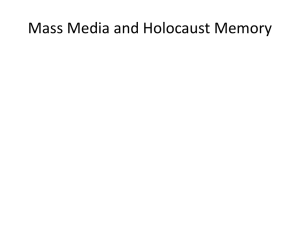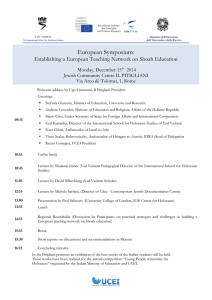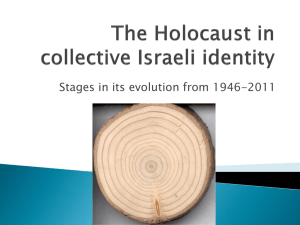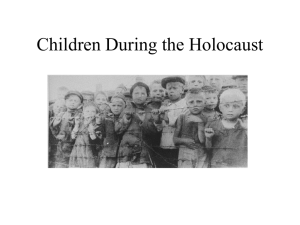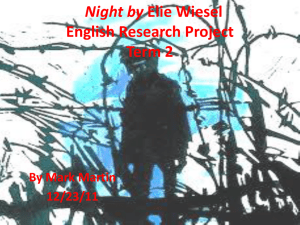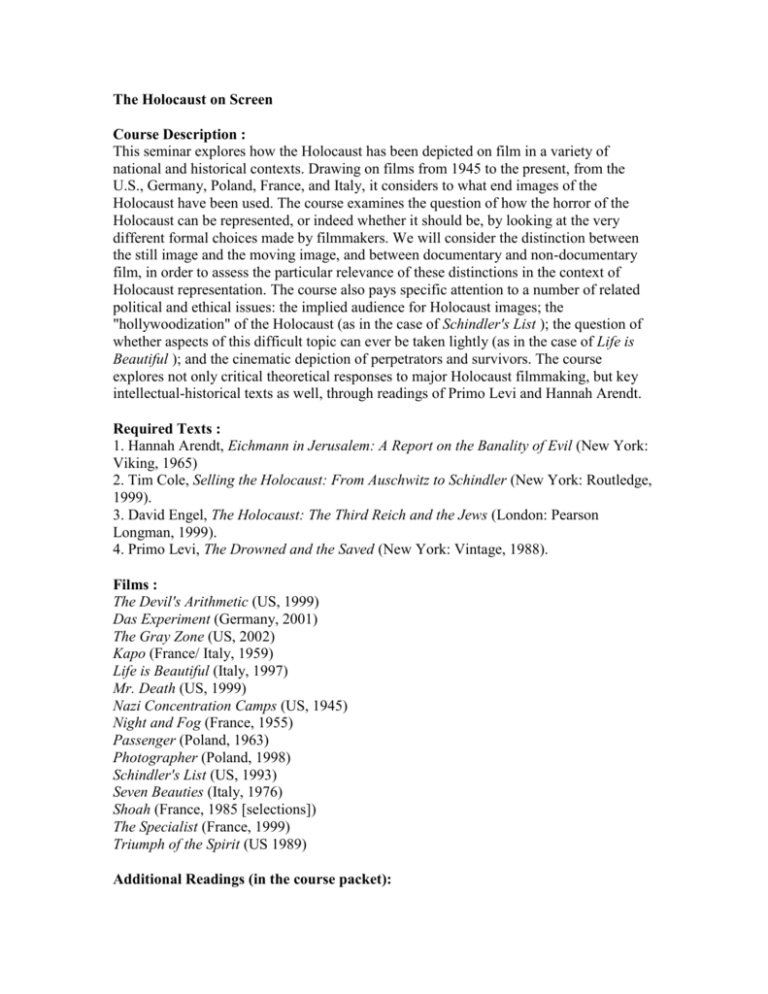
The Holocaust on Screen
Course Description :
This seminar explores how the Holocaust has been depicted on film in a variety of
national and historical contexts. Drawing on films from 1945 to the present, from the
U.S., Germany, Poland, France, and Italy, it considers to what end images of the
Holocaust have been used. The course examines the question of how the horror of the
Holocaust can be represented, or indeed whether it should be, by looking at the very
different formal choices made by filmmakers. We will consider the distinction between
the still image and the moving image, and between documentary and non-documentary
film, in order to assess the particular relevance of these distinctions in the context of
Holocaust representation. The course also pays specific attention to a number of related
political and ethical issues: the implied audience for Holocaust images; the
"hollywoodization" of the Holocaust (as in the case of Schindler's List ); the question of
whether aspects of this difficult topic can ever be taken lightly (as in the case of Life is
Beautiful ); and the cinematic depiction of perpetrators and survivors. The course
explores not only critical theoretical responses to major Holocaust filmmaking, but key
intellectual-historical texts as well, through readings of Primo Levi and Hannah Arendt.
Required Texts :
1. Hannah Arendt, Eichmann in Jerusalem: A Report on the Banality of Evil (New York:
Viking, 1965)
2. Tim Cole, Selling the Holocaust: From Auschwitz to Schindler (New York: Routledge,
1999).
3. David Engel, The Holocaust: The Third Reich and the Jews (London: Pearson
Longman, 1999).
4. Primo Levi, The Drowned and the Saved (New York: Vintage, 1988).
Films :
The Devil's Arithmetic (US, 1999)
Das Experiment (Germany, 2001)
The Gray Zone (US, 2002)
Kapo (France/ Italy, 1959)
Life is Beautiful (Italy, 1997)
Mr. Death (US, 1999)
Nazi Concentration Camps (US, 1945)
Night and Fog (France, 1955)
Passenger (Poland, 1963)
Photographer (Poland, 1998)
Schindler's List (US, 1993)
Seven Beauties (Italy, 1976)
Shoah (France, 1985 [selections])
The Specialist (France, 1999)
Triumph of the Spirit (US 1989)
Additional Readings (in the course packet):
Améry, Jean, "Torture," At the Mind's Limits , trans. by Sidney Rosenfeld and Stella P.
Rosenfeld (Bloomington: Indiana UP, 1980).
Apel, Dora, "The Tattooed Jew," Visual Culture and the Holocaust , ed. Barbie Zelizer
(New Brunswick, NJ: Rutgers UP, 2001) 300-320.
Barnow, Dagmar, "To Make them See: Photography, Identification, and Identity,"
Germany 1945 (Bloomington: Indiana UP, 1996) 1-41.
Bartov, Omer, "Spielberg's Oskar: Hollywood Tries Evil," Spielberg's Holocaust:
Critical Perspectives on Schindler's List , ed. Yosefa Loshitzky (Bloomington: Indiana
UP, 1997) 41-60.
Bathrick, David, "Rescreening the Holocaust: The Children's Stories," New German
Critique 80 (2000) 41-59.
Brink, Cornelia, "Secular Icons: Looking at Photographs from Nazi Concentration
Camps," History and Memory 12.2 (2000) 135-50.
Borowski, Tadeusz, "This Way for the Gas, Ladies and Gentlemen," This Way for the
Gas, Ladies and Gentlemen in Art From the Ashes: A Holocaust Anthology , ed.
Lawrence Langer (Oxford: Oxford UP, 1995).
Browning, Christopher, "Initiation to Mass Murder: The Jozefow Massacre" excerpted
from Art From the Ashes: A Holocaust Anthology , ed. Lawrence Langer (Oxford:
Oxford UP, 1995).
Denby, David, "In the Eye of the Beholder. Another look at Roberto Benigni's Holocaust
fantasy," The New Yorker (March 1999) No 15, 96-99.
Gilman, Sander, "Is Life Beautiful? Can the Shoah be Funny? Some Thoughts on Recent
and Older Films," Critical Inquiry 26.2 (2000) 279-308.
Hirsch, Marianne, "Nazi Photographs in Post-Holocaust Art: Gender as an Idiom of
Memorialization," Phototextualities: Intersections of Photography and Narrative , ed.
Alex Hughes and Andrea Noble (Albuquerque: U of New Mexico P 2003) 19-40.
Jacobitz, Florence, "Shoah as Cinema," Image and Remembrance: Representation and
the Holocaust ed. Shelley Hornstein and Florence Jacobowitz (Bloomington: Indiana UP,
2003) 7-21.
Krantz, Charles, "Teaching Night And Fog : History And Historiography," Film and
History 15.1 (1985) 2-15.
Lacapra, Dominick, "Lanzmann's Shoah : 'Here There Is No Why'," Critical Inquiry 23
(1997) 231-69.
Lang, Berel, Holocaust Representation : Art within the Limits of History and Ethics
(Baltimore: Johns Hopkins UP, 2000) excerpts.
Lanzmann, Claude, "Seminar with Claude Lanzmann: 11 April 1990," Yale French
Studies 79 (1991) 82-100.
Loshitzky, Yosefa, "Holocaust Others: Spielberg's Schindler's List versus Lanzmann's
Shoah ," Spielberg's Holocaust: Critical Perspectives on Schindler's List , ed. Yosefa
Loshitzky (Bloomington: Indiana UP, 1997) 104-18.
Nyiszli, Dr. Mikos, Auschwitz: A Doctor's Eye-Witness Account (London: Panther, 1960)
excerpts.
Sofsky, Wolfgang, The Order of Terror : T he Concentration Camp, trans. William
Templer (Princeton, N.J. : Princeton UP, 1997 ) excerpts.
Struk, Janina, Photographing the Holocaust: Interpretations of the Evidence (New York:
Palgrave, 2004) excerpts.
Todorov, Tzvetan, Facing the Extreme: Moral Life in the Concentration Camps , trans.
Arthur Denner and Abigail Pollak (New York: Metropolitan Books, 1996) excerpts.
Yolen, Jane, The Devil's Arithmetic (New York: Viking, 1988) exerpts.
Zemel, Carol, "Emblems of Atrocity: Holocaust Liberation Photographs," Image and
Remembrance Representation and the Holocaust ed. Shelley Hornstein and Florence
Jacobowitz (Bloomington: Indiana UP, 2003) 201-19.
Syllabus
Screening : (in class) Nazi Concentration Camps (US, 1945, 59 Minutes [exerpts])
Reading :
1. Dagmar Barnow, "To Make them See: Photography, Identification, and Identity"
Screening : Night and Fog (France, 1955, 32 Minutes), and Hitler Gives a City to the
Jews (Germany 1944, 23 Min)
Reading :
1. Charles Krantz, "Teaching Night And Fog : History And Historiography"
2. Carol Zemel, "Emblems of Atrocity: Holocaust Liberation Photographs"
3. Cornelia Brink, "Secular Icons: Looking at Photographs from Nazi Concentration
Camps"
Screening : Photographer (Poland, 1998, 52 minutes), also, begin screening of Shoah
1. Janina Struk, Photographing the Holocaust , Chapter 4 ("Cameras in the Ghettos")
2. Marianne Hirsch, "Nazi Photographs in Post-Holocaust Art: Gender as an Idiom of
Memorialization"
Screening : Shoah (France, 1985, [selections])
Reading :
1. Claude Lanzmann, "Seminar with Claude Lanzmann: 11 April 1990"
2. Florence Jacobwitz, " Shoah as Cinema"
3. Dominick Lacapra, "Lanzmann's Shoah : 'Here There Is No Why'"
Screening : Kapo (France/ Italy, 1959, 116 Minutes)
Reading :
1. Wolfgang Sofsky, The Order of Terror , 28-43
2. Tadeusz Borowski, "This Way for the Gas, Ladies and Gentlemen"
3. Berel Lang, Holocaust Representation , Chapter 1, 17-34
Screening : The Gray Zone (US, 2002, 108 Minutes)
Reading :
1. Miklos Nyiszli, Auschwitz: A Doctor's Eye-Witness Account (introduction by Burno
Bettelheim + chapter 19)
2. Jean Améry, "Torture" in At the Mind's Limits
3. Primo Levi, "The Gray Zone," (Chapter 2 of The Drowned and the Saved)
Screening : Passenger (Poland, 1963, 62 minutes) [also, in class, excerpts from The Night
Porter (US, 1974)]
Reading :
1. Berel Lang, Holocaust Representation , Chapter 8, 140-57
2. Primo Levi, "Useless Violence," (Chapter 5 of The Drowned and the Saved )
Screening : Seven Beauties (Italy, 1976, 115 Minutes)
Reading :
1. Wolfgang Sofsky, The Order of Terror , 214-22
2. Primo Levi, "Shame" (Chapter 3 of The Drowned and the Saved ).
3. Tzvetan Todorov, "A Place for Moral Life?" 31-46
Screening : Triumph of the Spirit (US, 1989, 120 Minutes)
Reading :
1. Wolfgang Sofsky, The Order of Terror , 117-29
2. Tzvetan Todorov, "Dignity," 59-70.
Screening : Schindler's List (US, 1993, 194 Minutes)
Reading :
1. Tim Cole, "Oskar Schindler," Selling the Holocaust: From Auschwitz to Schindler ,
73-94.
2. Omer Bartov, "Spielberg's Oskar: Hollywood Tries Evil"
3. Yosefa Loshitzky, "Holocaust Others: Spielberg's Schindler's List versus Lanzmann's
Shoah "
Screening : The Devil's Arithmetic (US, 1999, 95 Minutes)
Reading :
1. Jane Yolen, The Devil's Arithmetic , Chapter 11
2. Dora Apel, "The Tattooed Jew"
* No Class Thursday - Veterans' Day
Screening : Life is Beautiful (Italy, 1997, 118 Minutes)
(additional optional screening: Train of Life [France/ Belgium, 1998, 103 Minutes])
Reading :
1. David Denby, "In the Eye of the Beholder. Another look at Roberto Benigni's
Holocaust fantasy"
2. David Bathrick, "Rescreening the Holocaust: The Children's Stories"
3. Sander Gilman, "Is Life Beautiful? Can the Shoah be Funny? Some Thoughts on
Recent and Older Films"
Screening : The Specialist (France, 1999, 128 Minutes)
Reading :
Tim Cole, "Adolf Eichmann," Selling the Holocaust: From Auschwitz to Schindler , 4772.
*Begin Hanna Arendt, Eichmann in Jerusalem: A Report on the Banality of Evil
(chapters 1, 2, and 14).
* No Class Thursday - Thanksgiving
Screening : Mr. Death (US, 1999, 91 Minutes)
Reading :
Hanna Arendt, Eichmann in Jerusalem (chapters 3, 6, and 8).
Screening : Das Experiment (Germany, 2001, 120 Minutes)
Reading :
1. Christopher Browning, "Initiation to Mass Murder: The Jozefow Massacre"
2. Hanna Arendt, chapter 15 and the epilogue.




